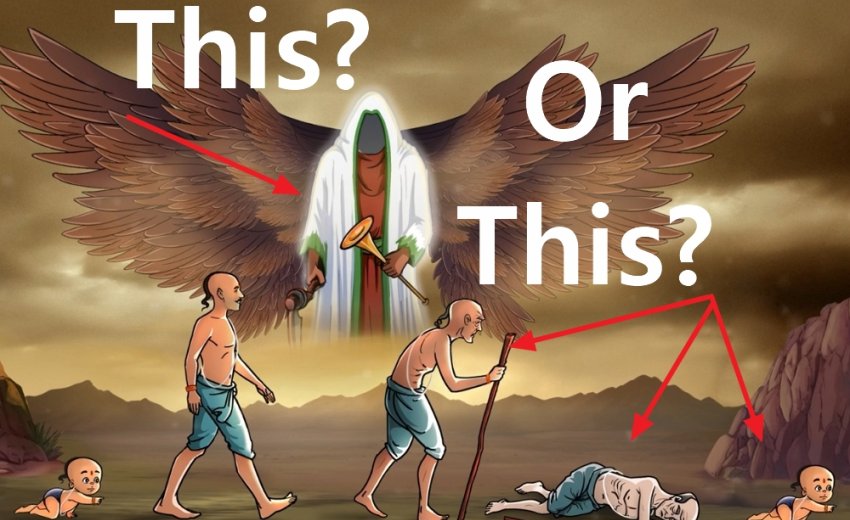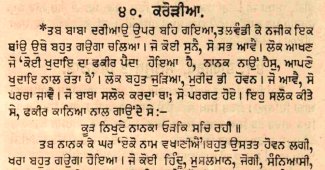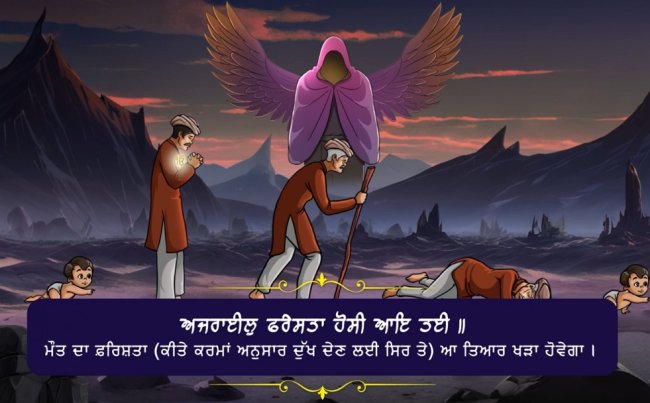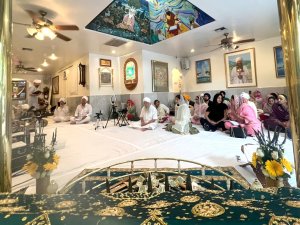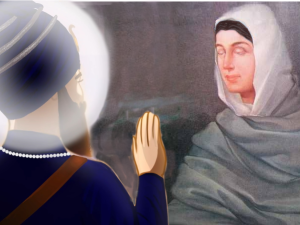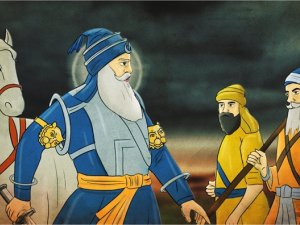In this story I looked at a Puratan Janam Sakhi and Nanak Prakash. The Puratan Janam Sakhi was more brief and basically confirmed the other text which is what I stuck to in this script. The elements that it confirmed were: Guru Nanak stopped by the river and started singing, a local millionaire heard a shabd (below) and disagreed with it, he mounted a horse which kicked him off, the next day he went to confront the Guru and he went blind, he then became humble to Guru, sangat advised him to get off horse and walk on foot, Guru Nanak was happy with his humility, he made a request to make a Dharamshala in Guru's name called 'Kartarpur' which was granted, Guru enlightened him.
This beautiful tale, from this precious text, can be found on the 99th digital page via Punjabi Digital Library.
Now, the more detailed version is found in Nanak Prakash (baag 2, adhiai 30) which contains more interactions with all parties and includes that the unnamed millionaire also lost his ability to speak (paurhi 35) before he lost his vision.
Words in the animation that you will find come directly from the text, and other elements not specified in the above version, are:
Millionaire’s internal thoughts of repentance (paurhi 36), comparing himself to a mosquito and a pebble (paurhi 43), he lays in a dandout prostration (46), Guru ji's words instructing him to open his eyes (48), Guru ji's words in response to his request to build a Dharamshala, "No one will stop you from doing that seva which is on your heart..." (52), Guru ji's wife and sons moved to live at Kartarpur(62), Guru farmed the land himself (63).
~~~~~~~~~~~~~~~~~~~~~~~~~~~~~~~~~~~~~~~~~~~~~~~~~~~~~~
There are two points about the story making process that I want to share to give a glimpse of the thinking and process of how it was made.
The first point that I felt the need to emphasize more was the reason that the millionaire doesn't like the teachings of Guru Nanak in the first place. Both texts narrate the following: Some people go around singing Shabds they heard from Guru Nanak. The millionaire hears one of them and believes that this will have a deleterious effect on both Hindus and Muslims. The Shabd is:
ਨਾਨਕੁ ਆਖੈ ਰੇ ਮਨਾ ਸੁਣੀਐ ਸਿਖ ਸਹੀ ॥
Says Nanak, listen, O mind, to the True Teachings.
ਲੇਖਾ ਰਬੁ ਮੰਗੇਸੀਆ ਬੈਠਾ ਕਢਿ ਵਹੀ ॥
Opening His ledger, God will call you to account.
ਤਲਬਾ ਪਉਸਨਿ ਆਕੀਆ ਬਾਕੀ ਜਿਨਾ ਰਹੀ ॥
Those rebels who have unpaid accounts shall be called out.
ਅਜਰਾਈਲੁ ਫਰੇਸਤਾ ਹੋਸੀ ਆਇ ਤਈ ॥
Azraa-eel, the Angel of Death, shall be appointed to punish them.
ਆਵਣੁ ਜਾਣੁ ਨ ਸੁਝਈ ਭੀੜੀ ਗਲੀ ਫਹੀ ॥
They will find no way to escape coming and going in reincarnation; they are trapped in the narrow path.
ਕੂੜ ਨਿਖੁਟੇ ਨਾਨਕਾ ਓੜਕਿ ਸਚਿ ਰਹੀ ॥੨॥
Falsehood will come to an end, O Nanak, and Truth will prevail in the end. ||2||(Ang 953)
The text doesn’t directly state why the rich fool took issue with the Shabd. To understand this, you will notice that there is a name mentioned in the Shabd which we don't hear about often in Gurbani: Azrael. This is the Islamic angel of death. The next pangti (sentence) talks about 'avan jaan', i.e. the coming and going of the soul, or reincarnation. So, these two lines show a juxtaposition. The first line features a core theme from Islamic belief and the next sentence references something that Muslims don't believe in: reincarnation. What's unspoken is that Gurbani is purposely blurring these religious lines in order to speak to the human soul which has no religion after it leaves this body.
It seems that listeners a couple hundred years ago wouldn't need an explanation to know how this Shabd would be perceived as religiously disruptive but I felt it needed to be explained more clearly, especially so the plot of the Saakhi can be properly understood by our young ones. The animation features clear visuals to illustrate what's being conveyed by Guru ji in this Shabd and how the millionaire interpreted it different. Namely that the non-distinction between Azrael and reincarnation dilutes the faith both religions.
The other point above the script I will like to explain is how it uses the Saakhi to create a moral in an unexpected way. The story is that an arrogant man is humbled by Guru Nanak and then dedicates himself to the Guru's teachings (along with helping to found Kartarpur). So why does the story end by talking about how sometimes we dissect Gurbani too much? Because I asked myself what internal process was the millionaire going through that we can personally relate to. These stories have to be meaningful for us today. While I'm not a millionaire (yet), I can relate to him in this way: he needed to get out of his head and into his heart. We all need to do this in general. Especially when it comes to religious teachings.
It doesn't do us any good to be an encyclopedia of information on Sikhi, philosophize endlessly, memorize a ton of Shabds, know all Sikh history etc. if we end up walking around with big heads while our heart doesn't grow bigger. To be clear, it's still good to do these things (besides having a big head), but not at the expense of losing our sense of bhagti. The person who knows only one Shabd, but has pure devotion, is more on the path of Sikhi. If we are in our heads we will talk about Guru's teachings but won't feel it in the moment, in the day-to-day interactions and inspirations that Guru is constantly gracing us with. We will miss the moment, miss the subtle presence of Guru in our lives. And we will certainly miss how the spirit of Sikhi would transfer to others around us, including our youth. That's why this was included in the moral at the end:
"Like the millionaire, we can also sometimes get stuck in our heads, by hyper dissecting the Guru's teachings, like they are some relics that are not alive. No, the Guru is alive. And the truth is known from our hearts."
Even if we are not scholars, or don't listen to religious debates, whoever we are, it's important that we don't simply take this story and relegate it to the annals of history. Even though we may be Sikhs, if we are stuck in our heads thinking we have the right interpretation of Sikhi and other Sikhs are fools, we are the in same position as the millionaire was. We will meet Guru Nanak when we take the understanding that is in our heads and toss it up in the sky. Then instead we feel the Guru's teachings in our hearts.
That's what we can take from this Saakhi.
This is a deep teaching, not just for children, which is of the greatest important for our whole lives.

